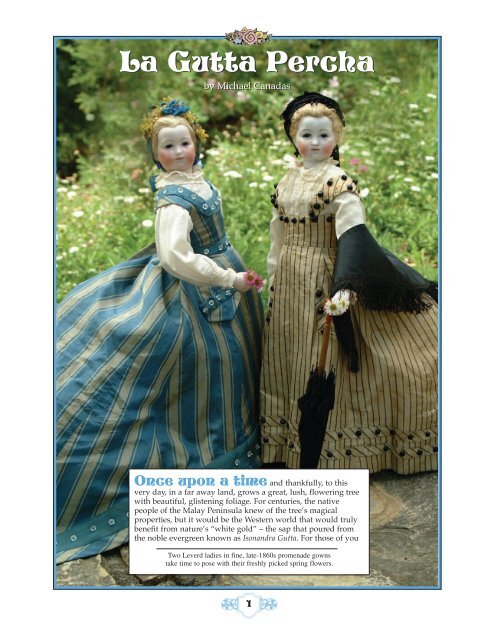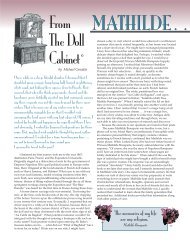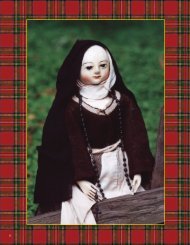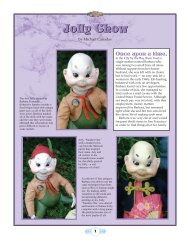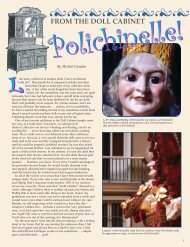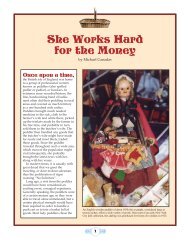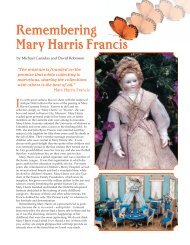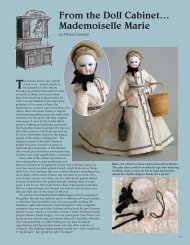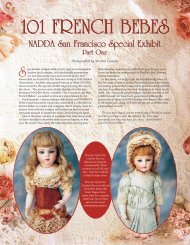La Gutta Percha La Gutta Percha - Carmel Doll Shop
La Gutta Percha La Gutta Percha - Carmel Doll Shop
La Gutta Percha La Gutta Percha - Carmel Doll Shop
- No tags were found...
You also want an ePaper? Increase the reach of your titles
YUMPU automatically turns print PDFs into web optimized ePapers that Google loves.
<strong>La</strong> <strong>Gutta</strong> <strong>Percha</strong>by Michael CanadasOnce upon a time and thankfully, to thisvery day, in a far away land, grows a great, lush, flowering treewith beautiful, glistening foliage. For centuries, the nativepeople of the Malay Peninsula knew of the tree’s magicalproperties, but it would be the Western world that would trulybenefit from nature’s “white gold” – the sap that poured fromthe noble evergreen known as Isonandra <strong>Gutta</strong>. For those of youTwo Leverd ladies in fine, late-1860s promenade gownstake time to pose with their freshly picked spring flowers.1
Note how the lambskinwig follows the shape ofthe recessed hairline.Leverd examples areknown for theirmagnificent hairstyles,if they are luckyenough to haveretained them.familiar with gutta percha, typically black, ordark brown items instantly come to mind. Youmay find it strange to imagine the raw sapharvested from the gutta tree is in fact, milkywhite in its natural state! Through heat processingof the sap, it turns a deep, rich color. The use ofgutta percha is associated with many differentforms of scientific and decorative objects, createdthroughout the nineteenth and early twentiethcenturies. Such items include ornate mourningjewelry, underwater-cable insulation,daguerreotype cases, dental implements,furniture and even golf balls! Some say the use ofgutta percha revolutionized the game of golf andtelecommunications during the nineteenthcentury would have been non-existent without it.The process of evaporating the milky fluidharvested from the immense tree, thencoagulating the latex produced gutta percha.Shaping it into inelastic bricks for export was thefinal step in the process. The manufacturer wouldsimply buy bricks of gutta percha and with littleeffort, soften the material in hot water – itremained firm, but not brittle when it cooled. Theforerunner to our modern-day latex, gutta perchacould also be processed so that it resembled thecolor of maple wood. It could easily be given acolorant or paint finish – even gold leafing –resulting in what many artisans thought wasan easy to use, pliable and moldablematerial that accepted a high-definitionform, from that molding. Its uses weredeemed – unlimited.In the mid-nineteenth century,France was at the forefront of theluxury-goods renaissance spreadingthroughout the world and any newmaterial would have been of greatinterest to the myriad realms ofmanufacturing, including the toybusiness.The doll world, then and now,always seems to have its eyespeeled for the latest trends, so itabsolutely follows that guttapercha would find its way intoFrance’s burgeoning doll industry.All that was required of thoseFrench start up doll makers was aheating stove, a pot of water and amold. Voila – one could be in business!However, one also had to have at handthe eighty francs per brick of gutta percha!We in the doll world consider the Huretsisters to be the first to use gutta percha intheir doll enterprise when they designed and2
This body, although unmarked,completely follows the Leverd-patentedbody and head.This image of the body’s reverseillustrates the remarkable condition,plus the prominently marked head.It is obvious that the thin leather wasstretched and glued over the gutta perchabase components, rather than stitched.Details of the shaped, recessedhairline-a trademark feature ofthe Leverd dolls.3
The tiny molded and painted teeth of theLeverd are easy to miss upon first glance.patented a thoughtful, articulated, hollow dollbody from the material. From a successfulbusiness family, which included handcrafting ofall sorts of useful goods – from locks to exquisiteiron furniture, the sisters stepped into the worldof doll making and they literally helped launchan entire market that simply did not exist before.Many young entrepreneurs looking for successfound Paris to be a city of vast opportunity.During the reign of Emperor Napoleon III, at onepoint the city counted over two hundred dollmakers and assemblers. Fine boutiques were setup to supply the world with the most fashionablearticles de Paris and it was indeed Paris, in whichthe firm of Leverd et Cie appeared in those rankswhile incorporating bisque, wax, and gutta perchato create some of the most splendid fashion dollsthat would grace the Second Empire.The firm of Leverd et Cie., (later known as<strong>La</strong> <strong>Gutta</strong> <strong>Percha</strong>) created masterpieces which formany years have been incorrectly attributed tothe Austrian, Josef Kubelka. It is through thetireless effort of one of the world’s leadingresearchers, namely François Theimer along withhis wife Danielle, that insight has been brought tomany obscure inventors and manufacturers,thereby providing proper attributions.It was during the year 1852, in which AlexandreLeverd went into partnership with Louis JosephArthur Decourdemanche. Advertising theyspecialized in rubber products, offerings includedcomponents such as hoses, washers, belts andseals, plus all types of molded objects includingsoles for ladies’ shoes made of gutta percha, alongwith a multitude of additional items, also madefrom the exotic substance.There has existed in modern times, a debateconcerning whether gutta percha was, wheninitially used, at all supple and flexible. It seems tothis writer, if gutta percha was used in the creationof soles for shoes, it must have been somewhatsupple. Furthermore, how strange for today’scollectors to imagine a gutta percha doll’s body ofa similar texture to that of a modern vinyl doll!A. Leverd & Cie. was first located at 218 rueFaubourg Saint Martin and later moved to thefashionable Boulevard des Italiens. The companyenjoyed success, participated in expositions andwon a silver medal at the 1855 ExpositionUniverselle. Additional medals were taken in1860 and 1867. A new partner, Nicolas Joliet,bought into the firm in 1867 – also the year thename of the firm was changed to <strong>La</strong> <strong>Gutta</strong>-<strong>Percha</strong>. Already known in the doll-making world,Nicolas Joliet was able to buy into the Leverdfirm with funds from the sale of his patent for a4
The character-like modelingof the Leverd doll’s facelends her an extremelyunique personality.The leather covered, guttapercha body is capable ofcountless poses!Both the Leverd stamp andthe sticker from theboutique, Maison Bail, withits fashionable address-astone’s throw from theLouvre, enhance both thevalue and mystique of thisvery rare doll.5
The wear to the body caused by the moving joint allows us the opportunity to seethe layers of linen and gutta percha utilized in the body’s manufacture.doll with two faces. (The sale was made to BRU Jne. et Cie and we all know that Brudid in fact utilize the patent for the creation of both two-faced ladies and bebes.)In 1869, A. Leverd company filed its third patent and according to research by Mr.Theimer, and I paraphrase; The dolls which have been made up to the present time aremerely very imperfect reproductions of nature, both in terms of shape and movementof the main limbs... among materials used to make them is gutta percha, which whenused alone loses its suppleness and elasticity after a time… it can become brittle andbreak if hit or dropped. To make less fragile toys we have to use a very greatthickness, which adds useless and costly weight.The basis of the patent was to remedy the above problem by pressing a thin layerof gutta percha between two pieces of fabric, lending the doll body much morestrength and durability. The firm’s patent claimed, that with imaginative use of thetechnique, their dolls were “veritable artistic statuettes” capable of assuming “all kinds of positions”.There is one aspect of the bodies’ creation that seems to be left out of the patentdescription, because there is no mention of the outer layer of kid leather that wasstretched over the gutta percha/fabric components. No doubt, that “skin” gave thebody additional strength and if the gutta percha did fracture (and it did), it wasdiscreetly held in place by the leather.The movements afforded by the Leverd body design are smooth and very life-like,with lovely body proportions. However, when undressed, the way the doll sits issomewhat un-lady like and could have proven quite a shock to mothers and little girls!The bisque arms of the doll are high quality, but of standard stock, unlike thebisque heads that are unique to the Leverd firm alone. Also in use by the companywas a standard style leather body for their largest models, as gutta percha proved toocumbersome for them and was simply not cost effective. The leather body wouldhave been easily attainable and was fitted with either bisque, wood or leather arms.Today, doll collectors refer to the maker of a doll according to the company thatmade the heads, as opposed to the converse practice in use when the dolls wereinitially manufactured/ assembled. Interestingly, most doll-related patents are forbodies, usually concentrating on articulation. After all, there were many suppliers ofheads that a maker/assembler working in the 1860s and 1870s could choose from.6
Although attributed to Kubelka for decades, we nowknow this magnificent twenty-six inch doll to be aproduct of the A. Leverd firm.Note the detailed ear modeling of this largeLeverd model. This image also allows anexcellent view of the shaped hairline.A. Leverd & Cie was one of the few firms in business at that time, which had their ownheads created for their exclusive use. There are three known head styles and all sharethe feature of a realistic hair line. That marvelous illusion is achieved by modeling thehead in such a way that a shaped wig, or inserted hair, fits below the plane of theforehead and temples. So rather than the wig sitting on top of the bisque, it appears tobe actually growing out of the doll’s head! The wig can be made of animal skin as in thecase of their patent subject, but many examples feature a wax skullcap with implantedhair – even the most simple head style has a very lavish mohair wig.<strong>Doll</strong>s created by A. Leverd & Cie/<strong>La</strong> <strong>Gutta</strong> <strong>Percha</strong> are not always marked and thatfact contributes to their misattribution. We must offer thanks to those dedicatedindividuals who were willing to spend countless hours sorting through incredibleamounts of material, so that today, we collectors are able to refer to our dolls by theirproper names.It is impossible to speculate about the number of dolls produced by Leverdthroughout the company’s existence and just what percentage of revenue the dollscontributed to the company’s coffers overall. One fact is crystal clear, however,Leverd’s masterful works are among the greatest rarities of the doll world. The dollscreated by Leverd are also a tribute to the wonders of Mother Nature – their bodiesutilized a gift from a tree that grew in a far away land. Their heads – born from theplain earth and given life by fire… painted by artists that simply wanted to create atoy to captivate a child’s imagination… captivate, as they have mine, one hundredand forty five years later.8


